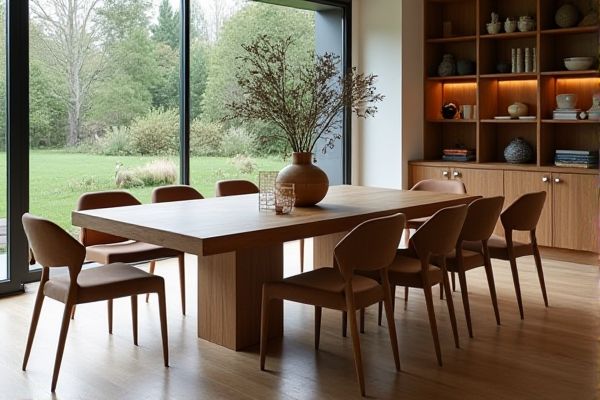
High top tables offer elevated surfaces ideal for casual dining and socializing, while standard tables provide traditional seating comfort suited for formal meals and work tasks. Explore this article to discover which table best fits Your space and lifestyle needs.
Table of Comparison
| Feature | High Top Table | Standard Table |
|---|---|---|
| Height | 40-42 inches (102-107 cm) | 28-30 inches (71-76 cm) |
| Seating | Bar stools or high chairs | Regular chairs |
| Usage | Casual dining, bars, social settings | Formal dining, offices, homes |
| Space Efficiency | Better for small or standing spaces | Requires more floor space |
| Comfort | Less comfortable for long seating periods | More comfortable for extended use |
| Style | Modern, casual look | Classic, versatile design |
Understanding High Top Tables
High top tables, typically ranging from 40 to 42 inches in height, offer a modern and casual seating option compared to the 28 to 30-inch standard tables commonly found in dining settings. These elevated tables encourage social interaction and are ideal for bars, cafes, and informal dining environments where standing or barstool seating is preferred. High top tables maximize space efficiency and create a dynamic atmosphere, making them popular for both commercial and residential use.
Defining Standard Tables
Standard tables typically feature a height of 28 to 30 inches, designed to accommodate regular chairs for comfortable dining or work settings. Their dimensions align with ergonomic standards, ensuring ease of seating and accessibility for a broad range of activities. Common in homes and offices, standard tables provide versatility and compatibility with various chair styles.
Key Differences Between High Top and Standard Tables
High top tables typically stand between 40 to 42 inches tall, designed for bar stools or standing use, while standard tables measure around 28 to 30 inches, intended for regular chairs and seated dining. The elevated height of high top tables creates a casual, social atmosphere ideal for bars and lounges, contrasting with the conventional comfort and formality of standard dining tables. Materials and designs can vary, but functionality and spatial usage primarily distinguish the two, influencing placement in commercial versus residential settings.
Space Efficiency: Which Table Wins?
High top tables optimize vertical space by allowing taller seating arrangements that occupy a smaller floor area compared to standard tables, making them ideal for compact or crowded environments. Standard tables typically require more floor space due to conventional chair dimensions and lower seating height, limiting their placement options in tight spaces. For maximizing spatial efficiency in compact settings like bars or cafes, high top tables generally provide the most effective solution.
Comfort and Ergonomics Comparison
High top tables offer better comfort for shorter, dynamic tasks by promoting active standing and improved posture, reducing strain on your lower back. Standard tables provide ergonomic support ideal for prolonged sitting, featuring adjustable heights and ample legroom to maintain neutral body alignment. Choosing between them depends on your specific usage, balancing comfort and ergonomics for optimal productivity.
Style and Aesthetic Appeal
High top tables elevate your space with a modern, casual vibe ideal for social settings, while standard tables offer a classic, versatile look that complements traditional interiors. The taller design of high top tables enhances openness and encourages interaction, whereas standard tables provide a grounded, familiar aesthetic. Choosing between the two depends on your desired ambiance and the style statement you want to make.
Ideal Settings for High Top Tables
High top tables are ideal for casual and social settings such as bars, cafes, and networking events, where standing or high stool seating encourages interaction and movement. Their height, typically 40 to 42 inches, suits spaces designed for informal gatherings or quick, comfortable conversations. Your choice of a high top table can elevate the ambiance and functionality in environments that benefit from lively, upright seating arrangements.
Best Uses for Standard Tables
Standard tables are ideal for versatile use in dining rooms, offices, and classrooms where comfort and accessibility are paramount. Their conventional height of around 28 to 30 inches facilitates seated interactions, making them perfect for meals, work, and study sessions. These tables accommodate a wide range of seating options and ergonomic needs, enhancing productivity and social engagement.
Pros and Cons of High Top Tables vs Standard Tables
High top tables offer a modern, space-saving design ideal for casual social settings, promoting standing interactions that enhance engagement but may cause discomfort during extended use. Standard tables provide classic comfort with ample seating and surface area, supporting longer meals or work sessions but often require more floor space. Choosing between high top and standard tables depends on balancing ergonomic needs, space constraints, and the intended use environment.
Choosing the Right Table for Your Space
High top tables offer a modern and casual vibe, ideal for social or bar areas, while standard tables suit formal settings and dining rooms with traditional seating. Your choice depends on spatial needs, as high tops save floor space and encourage standing or barstool seating, whereas standard tables provide comfort for extended sitting. Consider the functionality and layout of your space to select a table that enhances usability and complements your interior design.
 homyna.com
homyna.com